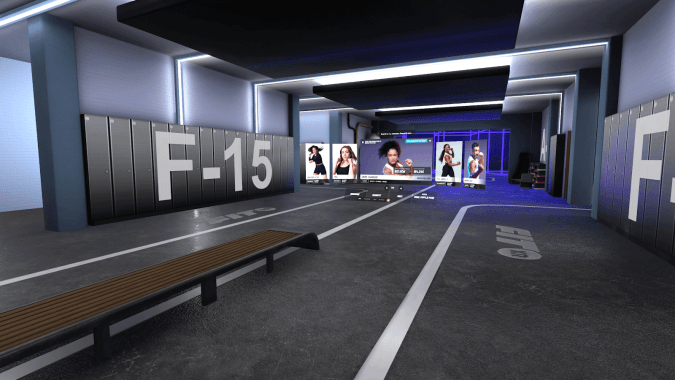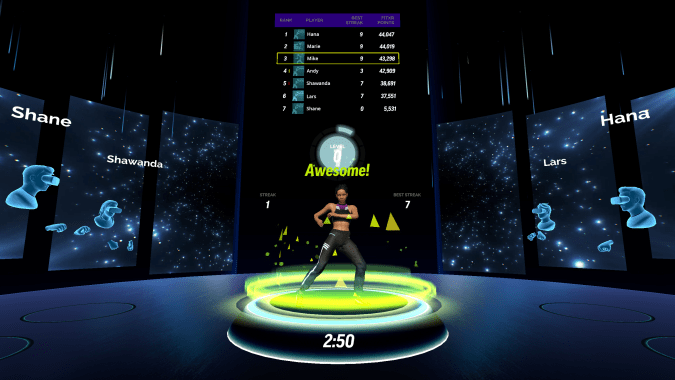[ad_1]
FitXR, formerly BoxVR, has been developing a virtual reality experience for at-home workouts for the last three years. The pandemic has helped make the case that people don’t need to visit a gym, but there’s still a sense that working out at home is a poor substitute for the sweat and bustle of a fitness club. That’s why the company is building a social component to their platform, letting users work out in tandem with their friends. Just as important, FitXR is shifting from a one-off payment to a monthly subscription, tempting users with the promise of a new workout each day. Is the world ready for a VR fitness club? Probably not, but FitXR is hoping to take a bold first step into that future.
When the title launched, it focused on VR boxing, with a system that resembled a rhythm game as objects flew toward you. Then, as the name changed, it broadened out to offer dance fitness classes, but that was never the final goal. Co-founder Sam Cole explained that the company is “leaning in to that concept of becoming a virtual fitness club,” with a raft of classes on offer. He added that the benefit of VR is that “you can get lost in an experience,” without distractions. Plus, while the workouts are tough, they’re a little more interesting than soullessly hitting a static bag in the corner of a refurbished warehouse.
In order to make FitXR’s new vision work, Oculus has had to change its policies to enable regular subscription payments on the Quest store. FitXR will, from today, be charging a $9.99 monthly fee for its product. As part of that fee, users will get unlimited access to the current library of classes available on the platform. Each day, a new class will be added, each one created by a team of professional fitness instructors. In the next few weeks, as well as the Boxing and Dance studios, the platform will add its own HIIT workout studio. And, as part of a deal with Warner Music and Pete Tong’s dance label FFRR, the classes will get a better soundtrack.
(“For the FitXR Steam, [Oculus] Rift and PSVR communities,” says the company, “we’re working to launch the membership model and related upgraded content in the near future.”)

FitXR
Users will also have the option to select from a number of new environments in which to work out, including a cliff-top studio, urban rooftop space or a dance studio. Over time, new environments will be added as the company builds out its library of classes.
FitXR is one of the first companies to take advantage of the new payment system, and Cole says the move is a “coming of age moment for VR in general.” He said that right now, the “pricing model is very similar to console games” where each title is sold separately, or additional functions are bought through DLC. But, in Cole’s word, “what VR ecosystems need is habitual use of the headset,” which can be tough if people don’t have a reason to keep coming back. Giving people a financial incentive to stick around is, Cole hopes, a way to encourage broader adoption of the technology.
Existing FitXR members will be given a free, 90-day trial of the new system, and should they choose to not sign up, will retain all of the content they originally bought. “We believed in providing long-term value for our customers, because we knew that this moment would arrive,” said Cole. He added that the company “really wanted to make sure that we protected those customers,” and that they didn’t feel they were being crunched in an effort for “revenue maximization.” Those users will also get access to multiplayer, as well as some beta classes for HIIT, as further reason to switch up.
In order to test the platform’s new multiplayer features, FitXR loaned me a Quest 2 loaded with a pre-release build of the new software. Cole said that it’s the Quest 2, more than anything else, which will enable the VR world of the future. That hardware, released in late 2020, is $100 cheaper than its predecessor, is lighter, faster and has a real claim to be the first truly mainstream VR headset. I tested out the new features with some members of the FitXR team, and while it’s not what you may hope for, it is a good first step.

FitXR
In order to begin, you have to access a private classroom, which is accessed by entering a six-digit code into a floating keypad. Once you’re all together, you start a class, with your friend’s head and hands floating off a short distance to your side. While you’re punching — we did a BoxVR drill — you can see your associates’ avatars in your peripheral vision. Now, since the system only knows the position of each headset relative to the hand controllers, it’s not exactly immersive. The most useful thing it lets you see is how quick they are at ducking the obstacles that periodically float toward your head.
What is valuable, however, is the ability to hear your friend’s playing and laughing along as you all run the workout. Even if you’re mostly concentrating on your own performance, you can’t help but flash a glance to your side, and there’s a nice feeling of community. There’s a little bit of silliness, and artificiality, but it’s best to lean into that experience rather than trying to play it cool. You can’t overstate the value of just having that sense of community, of being with people, after being stuck indoors for more than a year. No, it’s not the ability to play directly with a friend — we’re still a way from that — but it does feel like the start of something good.
The challenge for companies like FitXR and, hell, even Peloton, is that will we still want to work out at home when everyone’s been vaccinated? After all, the temptation will be to escape our homes and be among large groups of people as soon as COVID-19 has conclusively been put behind us. “We don’t need to be the exclusive part of people’s fitness journey,” said Cole, but he believes the pandemic will have shifted people’s priorities. He said that if you can reduce the number of needless trips you do with the use of VR, you can have more time living your life. He said that “in many cases, people have found that it’s simply a better way to get their exercise, opposed to going to what they thought was the only option, i.e., the gym.”
[ad_2]
Source link